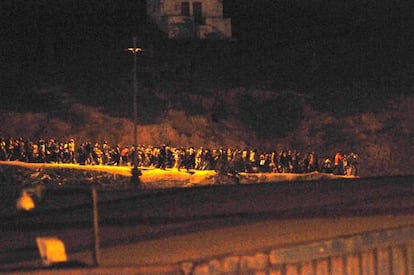Largest ever attempt made to storm Ceuta border fence repelled
Over 1,000 would-be immigrants try to enter Spanish exclave in two groups

A month after a large-scale entry attempt by sub-Saharan immigrants ended in tragedy in Ceuta, early Tuesday morning between 1,000 and 1,200 people launched a massive assault on the frontier separating the Spanish exclave from Morocco. The attempt was the largest single of its kind since would-be immigrants first employed the tactic of rushing the border fences en masse.
In February, several hundred sub-Saharans in two groups probed the fences, with many taking to the water to attempt to swim around the seawall that forms part of the border on Tarajal beach. Spanish security forces fired rubber bullets to repel the attempt, and 15 people are known to have drowned in the ensuing chaos. Spain has reiterated that its border personnel fired purely as a deterrent and away from the crush of humanity. Council of Europe Human Rights Commissioner Nils Muiznieks is planning to visit Ceuta and Melilla.
Until Tuesday, the largest attempts had been comprised of around 500 people. The central government delegation in Ceuta said that this assault had involved around 90 percent of the total number of immigrants camped out in the nearby mountains, where some remain for months or even years waiting for their chance to reach European soil. On this occasion the Civil Guard was not required, with Moroccan security forces driving back the attempt without reported incidents.
Other attempts were also launched, including 50 people who attempted the route around Tarajal beach and another 400 who tried the passageway at the border used by porters and traders. The security forces in Ceuta said they had been aware of the coming attempt because of the huge concentration of people building up in the mountains around the exclave.
According to the Civil Guard, none of the would-be migrants succeeded in reaching Spain on this occasion.
“The razor wire doesn’t stop them”
Dozens of immigrants who have successfully got into Melilla by scaling the fence – a forbidding barrier six meters high and topped with razor wire – have the scars to prove it: slashes on their faces, and their hands. Even those who don't make it pick up similar injuries.
The conservative government of Prime Minister Mariano Rajoy reintroduced the wire after it had been removed by the previous Socialist administration in 2007. However, the wire is not continuous along the fence but installed in certain sections that the government does not wish to reveal "for security reasons."
That is not a huge problem for people planning an attempt to enter Europe. "The sub-Saharans, who even know the shifts and timetables of the Civil Guards, know exactly which sections have it. They spend years up in the nearby mountains!" say Civil Guard sources.
The successful attempt of February 17, when 150 undocumented migrants reached Melilla, was made in the Villapajares area, between the border posts of Beni Enzar and Melilla's Chinatown, where there is no wire. "It has been installed in the places where the most attempts are made," said the government delegate in Melilla, Abdelmalik el Barkani, when the wire went up. But the immigrants, who know exactly where it is, simply try elsewhere.
"The razor wire doesn't stop them," says the Civil Guard. The opposition and NGOs strongly opposed the decision to reintroduce the wire, noting that the previous Socialist government installed similar in 2005 but removed it just two years later due to the horrific injuries it caused.
Tu suscripción se está usando en otro dispositivo
¿Quieres añadir otro usuario a tu suscripción?
Si continúas leyendo en este dispositivo, no se podrá leer en el otro.
FlechaTu suscripción se está usando en otro dispositivo y solo puedes acceder a EL PAÍS desde un dispositivo a la vez.
Si quieres compartir tu cuenta, cambia tu suscripción a la modalidad Premium, así podrás añadir otro usuario. Cada uno accederá con su propia cuenta de email, lo que os permitirá personalizar vuestra experiencia en EL PAÍS.
¿Tienes una suscripción de empresa? Accede aquí para contratar más cuentas.
En el caso de no saber quién está usando tu cuenta, te recomendamos cambiar tu contraseña aquí.
Si decides continuar compartiendo tu cuenta, este mensaje se mostrará en tu dispositivo y en el de la otra persona que está usando tu cuenta de forma indefinida, afectando a tu experiencia de lectura. Puedes consultar aquí los términos y condiciones de la suscripción digital.
Últimas noticias
Most viewed
- Alain Aspect, Nobel laureate in physics: ‘Einstein was so smart that he would have had to recognize quantum entanglement’
- Mexico’s missing people crisis casts a shadow over World Cup venue
- Why oil has been at the center of Venezuela-US conflicts for decades
- Trump clarifies who is ultimately in charge in Venezuela: ‘Me’
- Mexico seeks to shore up its defenses following US incursion in Venezuela








































